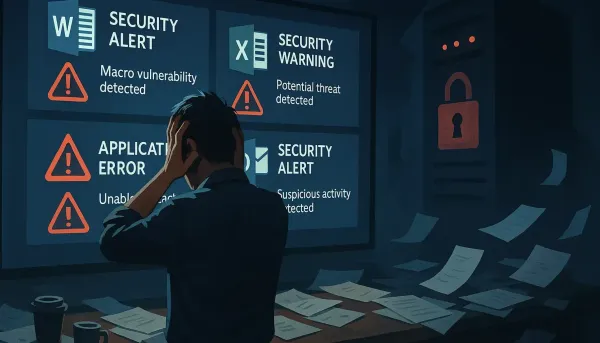
Microsoft Security Risks- Addressing Licensing and Outages
As the digital landscape continues to evolve, the frequency and complexity of incidents affecting critical services such as Microsoft 365 and Office applications underscore the vital importance of a robust cybersecurity posture. This blog post delves into some recent challenges experienced by Microsoft and the implications for IT administrators, focusing on security vulnerabilities, software updates, and ongoing outages.
In recent weeks, Microsoft has faced multifaceted challenges that have reverberated across its services. From urgent patches to fixing Office application crashes to ransomware propagation through compromised domain controllers, the current state of affairs demands the attention of cybersecurity professionals and IT administrators. It emphasizes the need for proactive monitoring and incident response strategies in a business environment heavily reliant on cloud-based services.
Office Application Crashes: The Implications and the Fix
The KB5002700 Update Fallout
On April 8, 2025, Microsoft rolled out the KB5002700 security update for Office 2016, aimed at addressing multiple vulnerabilities. Unfortunately, many users reported that after its installation, critical applications like Word, Excel, and Outlook would no longer launch. This predicament is a reminder of how security patches, while crucial for safeguarding against threats, can inadvertently disrupt business continuity if not properly tested.
The Urgent Mitigation: KB5002623
In response to the chaos, Microsoft issued an out-of-band update, KB5002623, two days later. This patch aimed to restore functionality to the Office suite. As Microsoft clarified, users must have both KB5002700 (the security update) and KB5002623 (the fix) installed to return the Office 2016 suite to a fully operational state.
Broader Context: The Importance of Change Management
This incident underscores the crucial aspect of change management within IT operations. Organizations must adopt rigorous testing protocols and rollback strategies to mitigate disruptions during patch deployments. Furthermore, these events highlight the need for maintaining robust backup solutions to facilitate recovery in scenarios where updates cause application failures.
Ransomware and Domain Controllers: A Growing Concern
The Vulnerability of Domain Controllers
In an alarming report released by Microsoft, it was revealed that breaches of domain controllers were involved in over 78% of human-operated cyberattacks, with domain controllers being the primary device for spreading ransomware in 35% of cases. This trend indicates a pressing vulnerability within enterprise environments, as these servers play a pivotal role in identity and access management through Active Directory (AD).
Recommendations for Securing Domain Controllers
- Strengthened Authentication: Implement multi-factor authentication (MFA) for administrative access to domain controllers to reduce the risk of credential theft.
- Network Segmentation: Isolate domain controllers from the general network to limit lateral movement by potential attackers.
- Regular Audits and Monitoring: Conduct regular security assessments and monitoring of domain controller logs to identify anomalous behavior indicative of compromise.
Microsoft’s Enhanced Features in Defender for Endpoint
In light of the growing threats, Microsoft has bolstered its Defender for Endpoint platform with containment features specifically for high-value assets such as domain controllers. By allowing administrators to enforce strict policies and monitor access closely, organizations can achieve a better balance between user accessibility and security.
Licensing Issues in Microsoft 365: Addressing User Access Disruptions
The Licensing Trouble
Recently, some users with Microsoft 365 Family subscriptions reported being erroneously informed that their licenses had expired. Microsoft acknowledged this issue as it affected user access, paralleling other service disruptions stemming from a recent update.
Steps Taken by Microsoft
To address these licensing issues, Microsoft has reverted recent changes suspected of causing the problem. Users were advised to refresh their apps and browsers to potentially rectify access problems.
Best Practices for Subscription Management
- Regular License Audits: Conduct periodic audits of user subscriptions to ensure compliance and functionality.
- User Education: Keep users informed about potential service outages and encourage them to report access issues promptly.
Ongoing Outages and User Access Challenges
Exchange Admin Center Outage
Adding to the list of recent complications, Microsoft experienced a global outage affecting access to the Exchange Admin Center (EAC). Users reported encountering HTTP Error 500 messages when attempting to log in to the portal, which inhibited administrative capabilities critical for managing Exchange Online services.
Mitigation Strategies Moving Forward
Microsoft has implemented temporary workarounds and is actively seeking to identify root causes of ongoing issues through diagnostic data. It’s essential for IT professionals to stay informed of service status updates and maintain communication with their teams during outages.
Conclusion
The recent string of incidents involving Microsoft software highlights the critical intersection of security and operational continuity for organizations that rely heavily on these services. The need for comprehensive monitoring, user education, and a well-established incident response protocol cannot be overstated. As cyber threats grow in complexity, the ability of organizations to adapt and respond swiftly will be paramount in mitigating risk and ensuring the integrity of their operations.
By remaining vigilant and proactive in cybersecurity management, IT professionals can navigate these challenges effectively, securing their organizations against both immediate threats and long-term vulnerabilities.